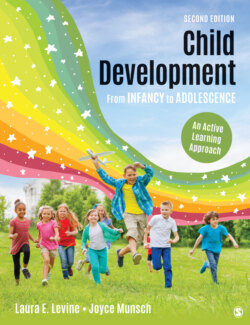Читать книгу Child Development From Infancy to Adolescence - Laura E. Levine - Страница 230
На сайте Литреса книга снята с продажи.
Tobacco
ОглавлениеAnother preventable source of developmental risk is maternal smoking, along with exposure to secondhand smoke, during pregnancy. Cigarette smoke contains over 4,000 chemicals, including formaldehyde, arsenic, and lead, many of which cross the placental barrier to reach the fetus (de Vocht, Simpkin, Richmond, Relton, & Tilling, 2015). The more a woman smokes or the longer into the pregnancy she smokes, the greater her risk of having a baby with low birth weight (de Vocht et al., 2015). Several mechanisms contribute to this growth restriction. As a woman smokes, the level of carbon monoxide in her blood increases and this reduces its capacity to carry oxygen. Because nicotine constricts blood vessels, this further limits the flow of oxygen and nutrients to the fetus through the placenta. Also, nicotine tends to suppress appetite so pregnant smokers eat less. All these factors contribute to the growth restriction so strongly associated with babies born to smokers. Perhaps surprisingly, maternal smoking is also associated with children being obese or overweight later in development. Researchers have speculated that childhood weight gain may be the body’s attempt to catch up or rebound from the earlier prenatal growth restriction (Banderali et al., 2015; Santos et al., 2016).
Smoking is associated with problems during the pregnancy, but also problems later in development. During the pregnancy there is an increased risk of miscarriage, premature birth, and sudden infant death syndrome (CDC, 2016r). It also affects lung development in a way that places the child at lifelong risk of respiratory problems (Banderali et al., 2015; McEvoy & Spindel, 2017). The risk of developing asthma, a serious childhood illness that is discussed in Chapter 8, is significantly increased if a mother smokes while pregnant, even if she does not smoke after the baby is born (Neuman et al., 2012). Maternal smoking is also a major contributor to later developmental problems for the child, including attention deficit/hyperactivity disorder (ADHD), conduct disorders, and learning disabilities (Rogers, 2009; Shea & Steiner, 2008; Slotkin, 2008). Babies born to smokers appear to undergo withdrawal symptoms similar to those seen in babies born to mothers addicted to illicit drugs, including higher levels of irritability and muscle tension (Stroud et al., 2009). It also is a strong predictor of whether adolescents begin smoking and become addicted themselves, regardless of whether their parents smoked during their childhood (Mamun et al., 2006).
While smoking has decreased among the general U.S. population over the last couple of decades, it has decreased at a slower rate among young women ages 19 to 29 than among other age groups. Just over 10% of pregnant women report smoking during the last 3 months of their pregnancy (CDC, 2016r). The good news is that stopping smoking at any point in a pregnancy is beneficial, but stopping completely and early in the pregnancy is best (ACOG, 2010, reaffirmed 2015). The bad news is that even when women are persuaded to stop smoking while they are pregnant or breastfeeding, many resume shortly thereafter (Xu, Wen, Rissel, & Baur, 2013). It would be beneficial to both mother and infant if we could find ways to make a smoke-free environment a long-term lifestyle change rather than a brief adaptation to the pregnancy itself.
